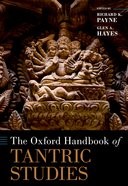 The Oxford Handbook of Tantric Studies
The Oxford Handbook of Tantric Studies
Contents
-
-
-
-
-
-
-
-
-
-
-
-
-
-
-
-
-
-
-
-
Introduction Introduction
-
Defining Tantrism Defining Tantrism
-
The First Soteriological Buddhist Tantras The First Soteriological Buddhist Tantras
-
Vajrayāna and the Sarvatathāgatatattvasaṃgraha Vajrayāna and the Sarvatathāgatatattvasaṃgraha
-
Beyond Convention and Conceptuality: The Guhyasamāja Beyond Convention and Conceptuality: The Guhyasamāja
-
The Subaltern Theophany of the Sarvabuddhasamāyoga The Subaltern Theophany of the Sarvabuddhasamāyoga
-
-
Pioneering Interpretations of Tantric Buddhist Soteriology Pioneering Interpretations of Tantric Buddhist Soteriology
-
Contesting Nonconceptuality: The Tattvasiddhi and the Sūtakamelāpaka Contesting Nonconceptuality: The Tattvasiddhi and the Sūtakamelāpaka
-
-
Carnal or Chaste: Monastic Receptions of the Guhyasamāja Carnal or Chaste: Monastic Receptions of the Guhyasamāja
-
Jñānapāda’s School of Guhyasamāja Interpretation Jñānapāda’s School of Guhyasamāja Interpretation
-
The Āryas’ Guhyasamāja Exegesis and the Kālacakra The Āryas’ Guhyasamāja Exegesis and the Kālacakra
-
-
Tantric Praxis as One of Three Ways to Salvation Tantric Praxis as One of Three Ways to Salvation
-
The Way of Mantras and the Way of the Perfections The Way of Mantras and the Way of the Perfections
-
The Nayatraya Treatises The Nayatraya Treatises
-
-
Conclusions Conclusions
-
Abbreviations Abbreviations
-
Notes Notes
-
References References
-
-
-
-
-
-
-
-
37 The Soteriologies of Buddhist Tantrism
Get accessIain Sinclair, The University of Queensland
-
Published:22 February 2024
Cite
Abstract
Tantric Buddhist practices, often regarded as transgressive or liminal, diverge from the sedate ways of the monastic establishment and the bodhisattva ideal of selfless altruism. The reconciliation of these quite different paths to enlightenment is one of the landmark intellectual projects of late Buddhism. Tantrism was conceived as a way (naya) or vehicle (yāna) leading to awakening that could be followed alongside monastic or bodhisattva religiosity in spite of its antinomian tendencies. The eradication of conceptuality (vikalpa) is one common goal that was especially suited to tantric methods, although views differed on the compatibility of these methods with Buddhist norms. The soteriology of Buddhist tantrism was developed over generations by members of the monastic community, such as Śāntarakṣita and deutero-Āryadeva; by non-monastic yogīs such as Indrabhūti and Padmavajra; and by adepts who had practised both monasticism and tantrism, such as Jñānapāda, Atiśa and Advayavajra.
Sign in
Personal account
- Sign in with email/username & password
- Get email alerts
- Save searches
- Purchase content
- Activate your purchase/trial code
- Add your ORCID iD
Purchase
Our books are available by subscription or purchase to libraries and institutions.
Purchasing information| Month: | Total Views: |
|---|---|
| February 2024 | 3 |
| March 2024 | 8 |
| April 2024 | 9 |
| May 2024 | 11 |
| June 2024 | 8 |
| July 2024 | 1 |
| August 2024 | 5 |
| October 2024 | 3 |
| November 2024 | 11 |
| December 2024 | 5 |
| January 2025 | 6 |
| February 2025 | 4 |

Get help with access
Institutional access
Access to content on Oxford Academic is often provided through institutional subscriptions and purchases. If you are a member of an institution with an active account, you may be able to access content in one of the following ways:
IP based access
Typically, access is provided across an institutional network to a range of IP addresses. This authentication occurs automatically, and it is not possible to sign out of an IP authenticated account.
Sign in through your institution
Choose this option to get remote access when outside your institution. Shibboleth/Open Athens technology is used to provide single sign-on between your institution’s website and Oxford Academic.
If your institution is not listed or you cannot sign in to your institution’s website, please contact your librarian or administrator.
Sign in with a library card
Enter your library card number to sign in. If you cannot sign in, please contact your librarian.
Society Members
Society member access to a journal is achieved in one of the following ways:
Sign in through society site
Many societies offer single sign-on between the society website and Oxford Academic. If you see ‘Sign in through society site’ in the sign in pane within a journal:
If you do not have a society account or have forgotten your username or password, please contact your society.
Sign in using a personal account
Some societies use Oxford Academic personal accounts to provide access to their members. See below.
Personal account
A personal account can be used to get email alerts, save searches, purchase content, and activate subscriptions.
Some societies use Oxford Academic personal accounts to provide access to their members.
Viewing your signed in accounts
Click the account icon in the top right to:
Signed in but can't access content
Oxford Academic is home to a wide variety of products. The institutional subscription may not cover the content that you are trying to access. If you believe you should have access to that content, please contact your librarian.
Institutional account management
For librarians and administrators, your personal account also provides access to institutional account management. Here you will find options to view and activate subscriptions, manage institutional settings and access options, access usage statistics, and more.